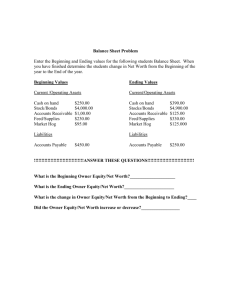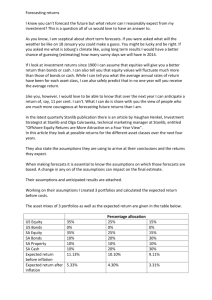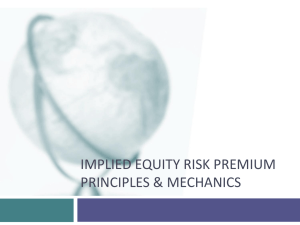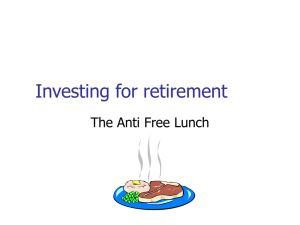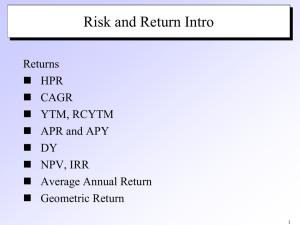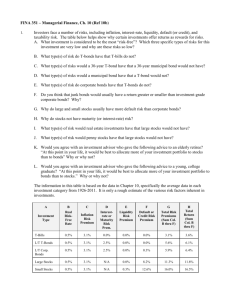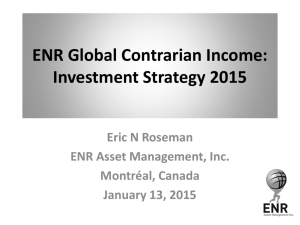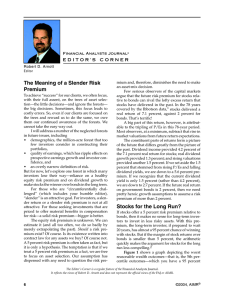Chapter 8 Practice Problems 1. A stock that sells for $100 entitles
advertisement
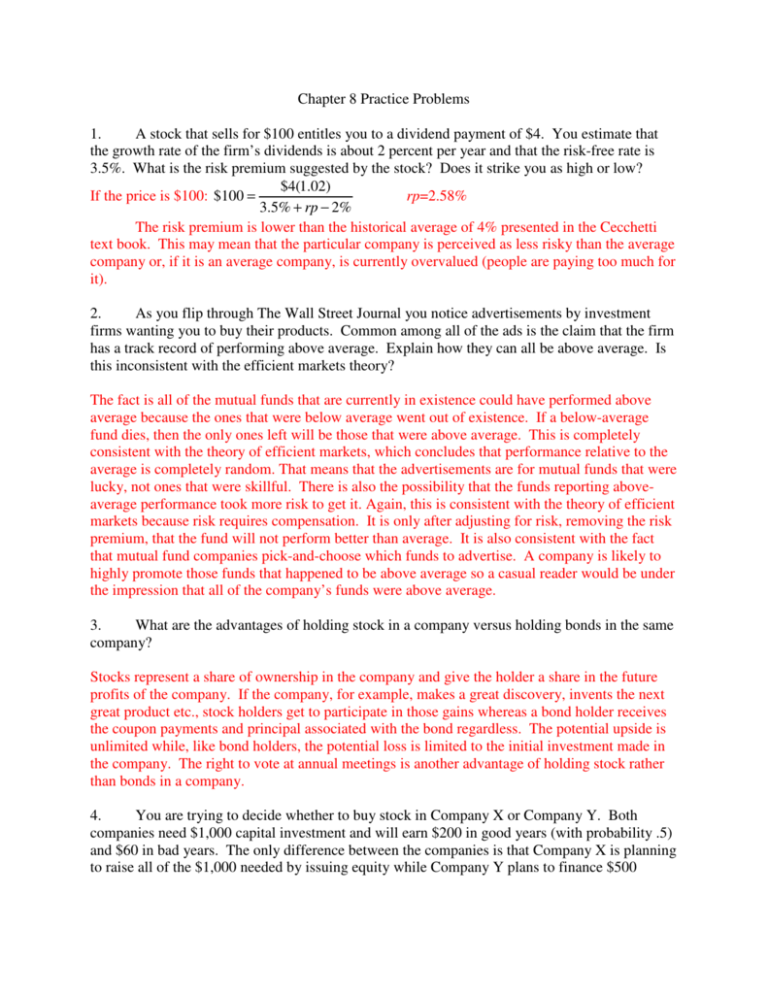
Chapter 8 Practice Problems 1. A stock that sells for $100 entitles you to a dividend payment of $4. You estimate that the growth rate of the firm’s dividends is about 2 percent per year and that the risk-free rate is 3.5%. What is the risk premium suggested by the stock? Does it strike you as high or low? $4(1.02) If the price is $100: $100 = rp=2.58% 3.5% + rp − 2% The risk premium is lower than the historical average of 4% presented in the Cecchetti text book. This may mean that the particular company is perceived as less risky than the average company or, if it is an average company, is currently overvalued (people are paying too much for it). 2. As you flip through The Wall Street Journal you notice advertisements by investment firms wanting you to buy their products. Common among all of the ads is the claim that the firm has a track record of performing above average. Explain how they can all be above average. Is this inconsistent with the efficient markets theory? The fact is all of the mutual funds that are currently in existence could have performed above average because the ones that were below average went out of existence. If a below-average fund dies, then the only ones left will be those that were above average. This is completely consistent with the theory of efficient markets, which concludes that performance relative to the average is completely random. That means that the advertisements are for mutual funds that were lucky, not ones that were skillful. There is also the possibility that the funds reporting aboveaverage performance took more risk to get it. Again, this is consistent with the theory of efficient markets because risk requires compensation. It is only after adjusting for risk, removing the risk premium, that the fund will not perform better than average. It is also consistent with the fact that mutual fund companies pick-and-choose which funds to advertise. A company is likely to highly promote those funds that happened to be above average so a casual reader would be under the impression that all of the company’s funds were above average. 3. What are the advantages of holding stock in a company versus holding bonds in the same company? Stocks represent a share of ownership in the company and give the holder a share in the future profits of the company. If the company, for example, makes a great discovery, invents the next great product etc., stock holders get to participate in those gains whereas a bond holder receives the coupon payments and principal associated with the bond regardless. The potential upside is unlimited while, like bond holders, the potential loss is limited to the initial investment made in the company. The right to vote at annual meetings is another advantage of holding stock rather than bonds in a company. 4. You are trying to decide whether to buy stock in Company X or Company Y. Both companies need $1,000 capital investment and will earn $200 in good years (with probability .5) and $60 in bad years. The only difference between the companies is that Company X is planning to raise all of the $1,000 needed by issuing equity while Company Y plans to finance $500 through equity and $500 through bonds on which 10 percent interest must be paid. In which company would you buy stock? Explain your answer. Company % equity % bonds Pay on bonds Pay to equity holders Equity return Expected Standard Value Deviation X 100 0 0 60-200 6-20% 13% 7% Y 50 50 50 10-150 2-30% 16% 14% (Remember, the expected value of the equity return is calculated as a % of the amount put into equity—1000 for company X and 500 for company Y.) Which company you choose depends on your attitude toward risk. If you are willing to take on extra risk by buying stock in Company Y, you get a higher expected return. If you are more risk averse, you may want to opt for the lower – but safer – return of company X. 5. Based upon the fundamental model of stock prices, what do you think would happen to stock prices if there were an increase in the perceived riskiness of bonds? The fundamental model of stock prices suggests the price paid for a stock is equal to D(1+g)/(rf + rp-g) where rf is the risk free rate of return, rp is the risk premium required for holding the stock, and g the annual growth rate of dividends, D. If investors perceive bonds are more risky, then the relative riskiness of stocks will fall. Stocks would become relatively more attractive, requiring a smaller risk premium than before. From the dividend discount model, we can see that a fall in the risk premium (which is in the denominator) would lead to a rise in stock prices. Note, this is also the same answer one gets when one realizes stocks and bonds are substitutes. As demand for bonds falls because of their perceived riskiness, demand for their substitutes (stocks included) rises leading to higher stock prices. 6. “If stock prices did not follow a random walk, there would be unexploited profit opportunities in the market.” Is this statement true, false, or uncertain? Explain. Yes. If movements in stock prices were predictable, then buyers and sellers could time their transactions in order to make profits based upon their knowledge. 7. If the public expects a corporation to lose $5 a share this quarter and it actually loses $4, which is still the largest in company history, what does the efficient market hypothesis say should happen to the price of the stock when the $4 loss is announced? The stock price should go up because the market received unexpected good news. One way to think of this is that the market’s price of the stock included the belief that it was going to lose $5 per share resulting in future lower dividend payments and, according to the fundamental valuation model, a lower share price today. When individuals learn the company will only lose $4, they quickly realize the current share price is too low and begin buying the stock thereby pushing its price up. 8. If your broker has been right in her 5 previous buy and sell recommendations, should you continue listening to her for advice? No, not based upon her past history. An efficient market does not preclude the possibility of luck, but unless your broker has inside information on her recommendations, she knows only a subset of all publicly available information which determines the price of a stock. After incorporating all of this information, a stock is as likely to increase as it is to decrease and hence your broker is unlikely to provide you with consistently beneficial information. 9. You are thinking about investing in stock in a company who paid a dividend of $10 this year and whose dividends you expect to grow at 4% a year. The risk free rate is 3% and you require a risk premium of 5%. If the price of the stock in the market is $200 a share, should you buy it? Yes. Using the dividend discount model, you are willing to pay: P = 10(1.04)/(0.08-.04) = $260 per share. As the asking price in the market is below this, you should buy the stock.

